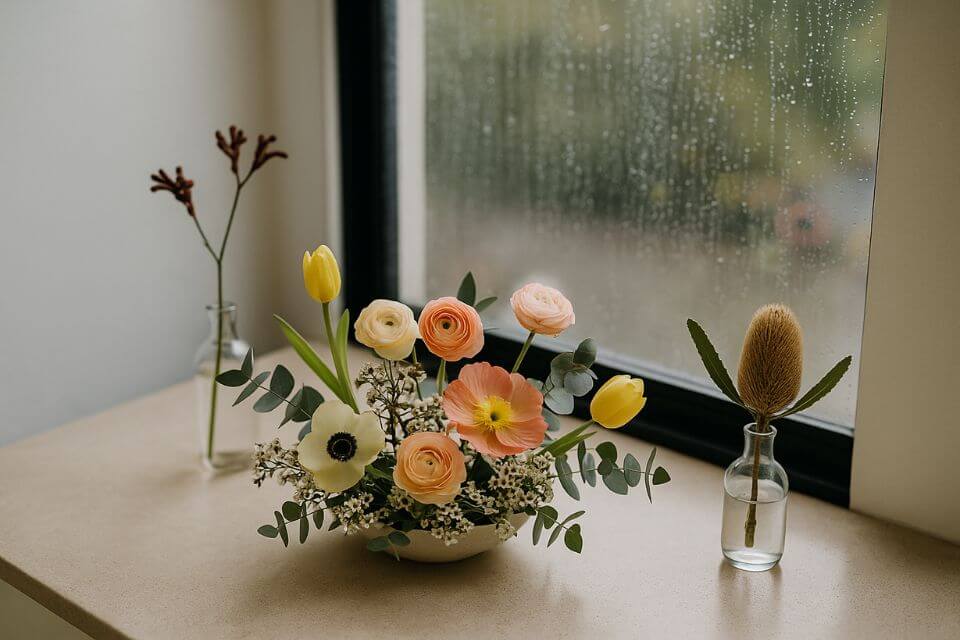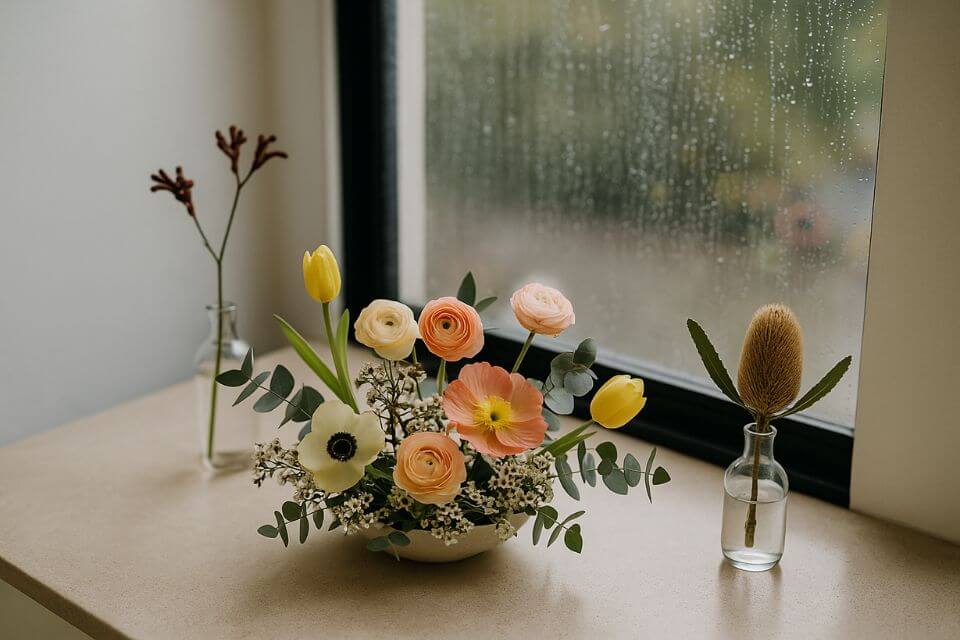Spring is officially on the calendar—but step outside and it’s all grey skies, cold winds, and “did someone forget to turn winter off?” weather. The good news: your home doesn’t have to wait for the sun to come out. Spring flowers are arriving in force across Australia, and with a little know-how you can make them shine (and last) even when it’s damp and chilly. Here’s your practical, feel-good guide to what’s in season, how to care for blooms in shoulder-season weather, and how to style flowers so your rooms feel like spring—no matter what the forecast says.
What’s in season now (and what’s coming)
Australia’s spring is a parade that starts strong in September and gathers pace until early summer. Depending on your region and local growers, you’ll likely see:
- Tulips & Ranunculus — cool-weather stars with clean lines and generous petals.
- Anemones & Sweet Peas — soft colour, delicate texture, and fragrance in the case of sweet peas.
- Narcissus (Paperwhites, Jonquils, Daffodils) — bright, cheerful, and tolerant of cooler rooms.
- Poppies — papery petals that open beautifully indoors.
- Garden Roses & Spray Roses — more availability as the season warms.
- Hydrangea (early cuts in warmer states) — big impact later in spring.
- Australian natives — Kangaroo Paw, Waxflower, Geraldton Wax, Leucadendron, Protea, Banksia; generous vase life and sculptural shape.
Peonies are the question everyone asks about. They’re later spring into early summer in Australia; timing shifts by region and season. If the weather feels wintry now, peonies may still be a few weeks off—ask your local supplier for the exact ETA.
Cold outside, cosy inside: why shoulder season is great for cut flowers
Chilly, overcast days can extend vase life—cool air slows respiration and reduces stress on stems. The catch? Heaters and dry indoor air can undo the advantage. A few adjustments will help you get the best of both worlds:
- Keep blooms away from heaters and fireplaces. Warm drafts dehydrate petals quickly.
- Mind the windows. Cold window glass + warm room air can create condensation; don’t wedge bouquets against panes.
- Use clean, tepid water. Very cold water can shock some stems; tepid helps with uptake after a long journey.
Conditioning 101: the five-minute ritual that doubles vase life
Think of conditioning as a mini spa for your flowers before they hit the vase.
- Clean the vase. Hot soapy water or a quick rinse with diluted bleach (then rinse again) keeps bacteria at bay.
- Trim stems. Cut 1–2 cm off at a 45° angle with sharp secateurs. Do this under running water if you can—stems won’t suck in air.
- Strip the waterline. Remove leaves that would sit below water. Foliage in water = bacteria growth.
- Flower food is your friend. Use the sachet provided; it balances sugars and biocides so you don’t have to guess.
- Let them drink. Give stems 30–60 minutes in water in a cool place before arranging.
Variety notes:
- Tulips keep growing in the vase (it’s part of their charm). If you want them straighter, wrap the bouquet in paper and stand it upright in deep water for an hour before arranging.
- Narcissus exude sap that can affect other flowers. Condition them alone for a few hours, then add to mixed bouquets.
- Hydrangea love water. If they flag, recut stems and submerge the heads in cool water for 20–30 minutes, then return to the vase.
- Woody natives (banksia, leucadendron) benefit from a longer diagonal cut; some florists lightly split the base to increase uptake.
If the weather is wild: delivery, transport, and “emergency fixes”
Spring in Australia still throws cold fronts and gusty rain. Protect your flowers like this:
- Transport tips: Keep arrangements upright and out of direct wind (no open car windows). Use a box or bucket to stabilise stems.
- On arrival: If petals feel cold, let flowers acclimatise for 10 minutes before trimming and placing in water.
- Bent-neck roses: Recut, then dip the first 2–3 cm of stem in hot (not boiling) water for 10 seconds, transfer to cool water, and let them recover.
- Storm drop-off: If you’re not home, leave a sheltered, shaded spot note for the courier—out of wind and rain, never in full sun behind glass.
Styling ideas that make a gloomy day feel like spring
You don’t need a giant arrangement to change the mood of a room. Try these easy wins:
1) Three-zone lift
Create three small moment-makers: a bud-vase cluster on the dining table, a compact posy on the kitchen bench, and a single statement stem (banksia or protea) on the entry console. The repetition of colour whispers “spring” as you move through the house.
2) Colour story, not colour chaos
Pick two main hues plus a neutral. For instance, butter yellow and blush with soft green foliage; or raspberry and coral with silvery eucalyptus. Keeping to a palette makes simple bunches look intentional.
3) Texture stack
Mix petal textures (silky tulips, ruffled ranunculus, papery poppies) with foliage that has character—parvifolia eucalyptus, olive, magnolia tip. Texture reads as “rich” even in low light.
4) Low, lush, camera-friendly
For dinner tables, go low so guests can see each other. Use a shallow bowl with a pin frog or chicken wire to create natural movement without height.
Natives: the spring MVPs for long-lasting impact
Australian natives are unbeatable when the weather is moody—structural, long-lasting, and comfortable in cooler rooms.
- Kangaroo Paw (Anigozanthos): Vibrant spikes; trim any blackened ends and remove spent florets to keep them tidy.
- Leucadendron: Architectural bracts that colour beautifully across the season.
- Protea & Banksia: Statement heads; change water every 2–3 days and keep leaves above the waterline.
- Waxflower & Geraldton Wax: Cloud-like filler with a gentle scent; great in mixed bunches.
Pair natives with a few softer imports (ranunculus, roses) if you like a “wild meets romantic” vibe.
FAQs for a wintry spring
“My house is heated—will flowers fade faster?”
Heat accelerates dehydration. Keep arrangements away from heater vents and fireplaces. Top up water daily. If the room is warm, choose natives, chrysanthemums, or carnations for longer life.
“Do I really need the flower food?”
Yes. It’s balanced for both hydration and bacteria control. If you’re out, change water daily and add a pinch of sugar plus a tiny splash of white vinegar as a stop-gap—but commercial food is best.
“How often should I change the water?”
Every 48 hours in a cool room; daily if your heater is running. Each change is a chance to trim stems again.
“Why do my tulips droop?”
They lean toward light and keep growing. Rotate the vase every day, keep them cool, and embrace a little curve—it’s part of their charm.
Hosting? Fast floral game plan for the weekend
- Pick a palette (two colours + neutral).
- Buy in threes: one hero bunch (e.g., tulips or natives), one filler (waxflower, snapdragon), one foliage.
- Condition everything the moment you get home.
- Arrange low for the table, taller for the hall.
- Refresh on the day: quick stem trim, fresh water, rotate vases away from direct sun.
If you’re short on time, pre-order a mixed spring bouquet and add a couple of market bunches to “stretch” it into multiple mini arrangements around the house.
Caring for cut flowers when you also have pot plants
Indoor greenery and cut flowers play well together—mostly. A few notes:
- Keep cut flowers out of direct plant mister spray. Moist petals mark easily.
- Avoid ethylene sources near bouquets (ripening fruit bowls are classic culprits).
- Don’t reuse flower water on pot plants. It can be bacteria-rich; use clean tap water for your ficus and ferns.
Choosing the right vase (size matters)
Spring stems range from delicate to chunky. Match the vase to the job:
- Cylinder vases suit tulips, roses, and ranunculus—neat and supportive.
- Wide bowls are great for low tablescapes; use a pin frog or grid to hold stems.
- Narrow-neck bottles make bud-vase clusters; group three to five for impact.
- Heavy bases are important for natives and big heads (banksia, protea) so nothing topples.
A simple, reliable spring recipe to copy
- 10 stems tulips (one colour)
- 5 stems ranunculus (tone-on-tone or soft contrast)
- 3–4 stems waxflower (or similar filler)
- A handful of eucalyptus parvifolia tips
Trim and spiral into a hand-tied bunch, then drop into a medium cylinder. It reads clean and modern, lasts well, and works in most rooms.
The sustainability angle (beautiful and sensible)
- Buy seasonal. Lower transport miles, fresher stems.
- Repurpose water. Use leftover vase water (before it turns) for outdoor pavers or lawns—not indoor plants.
- Compost spent stems where possible; woody natives can be chipped.
- Keep your vases. A small collection of shapes means you’ll always have the right tool for the next bunch.
Final stems: make your own spring
Weather will do what weather does. Inside your home, you’re in charge. With seasonal flowers, quick conditioning, and a few styling tricks, you can flip the mood from “mid-July” to “mid-September” in minutes. Start with one bunch on the kitchen bench, add a bud vase to the bathroom, and place a bold native in the hallway. Top up water, trim stems, rotate for light—and watch your rooms brighten, even while the clouds grumble outside.
When the real warm days finally arrive, your flowers will already be part of the rhythm of your home—changing with the weeks, bringing colour to grey mornings, and reminding you that spring isn’t just a forecast. It’s what you make of it.





